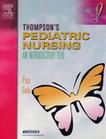Thompson儿科护理导论
2004-10
Elsevier Science Health Science div
Price, Debra L./ Gwin, Julie F.
502
Now part of the popular LPN Threads series, the new full-color edition of this market-leading textbook presents a clear, well-organized exploration of pediatric nursing for LPN/LVN students. It integrates cutting edge information with updated content, offering useful learning tools to reinforce fundamental concepts. Organized according to developmental stages, the book covers pediatric nursing from infancy to adolescence, with a separate chapter on end-of-life care for children and their families. With its easy-to-read, clear writing style, it provides exactly the right depth and breadth of content for LPN/LVNs. Skills teach basic techniques performed by the LPN/LVN in pediatric nursing settings. Healthy People 2010 objectives are incorporated throughout the text to familiarize readers with these key federal guidelines and objectives. Nursing Care Plans follow the nursing process format, with critical thinking question at the end. Nursing Briefs stress important content-related points to remember. A unique, built-in Self-Assessment workbook section, perforated at the back of the book includes study questions, case studies with critical thinking questions, matching, Internet activities, and multiple-choice questions. Online Resources at the end of each chapter offer a list of websites designed to stimulate interest and encourage further exploration of chapter topics. Communication Alert boxes identify key tips for establishing successful nurse-patient-family communication. Community Cues boxes address home care and community-based care issues. Data Cues list assessment data in convenient tables to "cue" the nurse to recognize possible pediatric disorders. Full-color LPN Threads design - with objectives, key terms, care plans with critical thinking questions, key points, bibliography and reader references, and more - makes this accessible, reader-friendly book even easier to use. NCLEX-PN Test Plan Comparison maps content from the text with the current test plan. Cultural content in the first chapter and throughout the book has been expanded, now with full-color photographs. Content on complementary and alternative therapies for pediatric patients includes representative examples of CAM therapies, a table on herbal therapies in the first chapter, and alternatives to traditional medication for pain. Pediatric psychophysiologic responses to bioterrorism and threats of bioterrorism are addressed. The new January 2004 Recommended Childhood Immunization Schedule is included in Appendix A. Provides basic information on Nursing Interventions Classifications (NIC) and Nursing Outcomes Classifications (NOC),promoting awareness and recognition of how these nursing languages are used.
Child Health Evolution, Health Care Evolution, Historical Perspective, Government Programs, Other Federal Programs, Then and Now, Changes in Mortality and Morbidity, Health CareToday, Insurance, Health Promotion, Bioterrorism, Role of the Pediatric Nurse, Cultural and Religious Considerations, Complementary and Alternative Medicine, Health Care Delivery Settings, Clinics and Offices, Home Care, Other Programs,2 Growing Children and Their Families, Heredity and the Developing Child, Karyotype, Genetic Counseling and Research, Advances in Perinatology, Growth and Development, Clarification of Terms, Characteristics of Growth and Development, Growth Standards, FactorsThat Influence Growth and Development, HereditaryTraits, Nationality and Race, Ordinal Position, Gender, Environment, Family, Theories of Development, Psychosocial Development, Cognitive Development, Moral Development, Nursing Implications of Growth and Development, 3 Care of the Hospitalized Child. The Hospital Experience, The Hospital Setting, The Child's Reaction to Hospitalization, The Family's Reaction to Hospitalization, The Nurse's Role, Admission Process. CriticalThinking and the Nursing Process, Documentation, Discharge Planning, Assessment of the Child, Systems Review, Vital Signs, Measurements, Safety. Transporting, Positioning, and Restraining the Child, Medical Asepsis, Preventing theTransmission of Infection, Education of the Family, Implications of Pediatric Surgery, The Child in Pain. Definition and Challenges. Assessment, Intervention, 4 The Newborn Infant. Adaptations of the Newborn Infant, ASSESSMENT OFTHE NEWBORN INFANT, Initial Assessment of the Newborn Infant, Airway, Umbilical Cord, Apgar Scoring, Providing Warmth, Measurements, Vital Signs, Characteristics of the Newborn Infant, Maturity, Head, Nervous System, Sensory System, Respiratory System, Circulatory System, Musculoskeletal System, Genitourinary System, ……5 The High-Risk Neonate,6 Disordersof the Newborn,7 The Infant8 Disorders of the Infant9 The Toddler10 Disorders of the Toddler,11 The Preschool Child,12 Disorders of the Preschool Child,13 The School-Age Child,14 Disorders of the School-Age Child15 The Adolescent16 Disorders of the Adolescent17 Pediatric Procedures,18 End-of-Life Care for Children and Their FamiliesAppendixes
